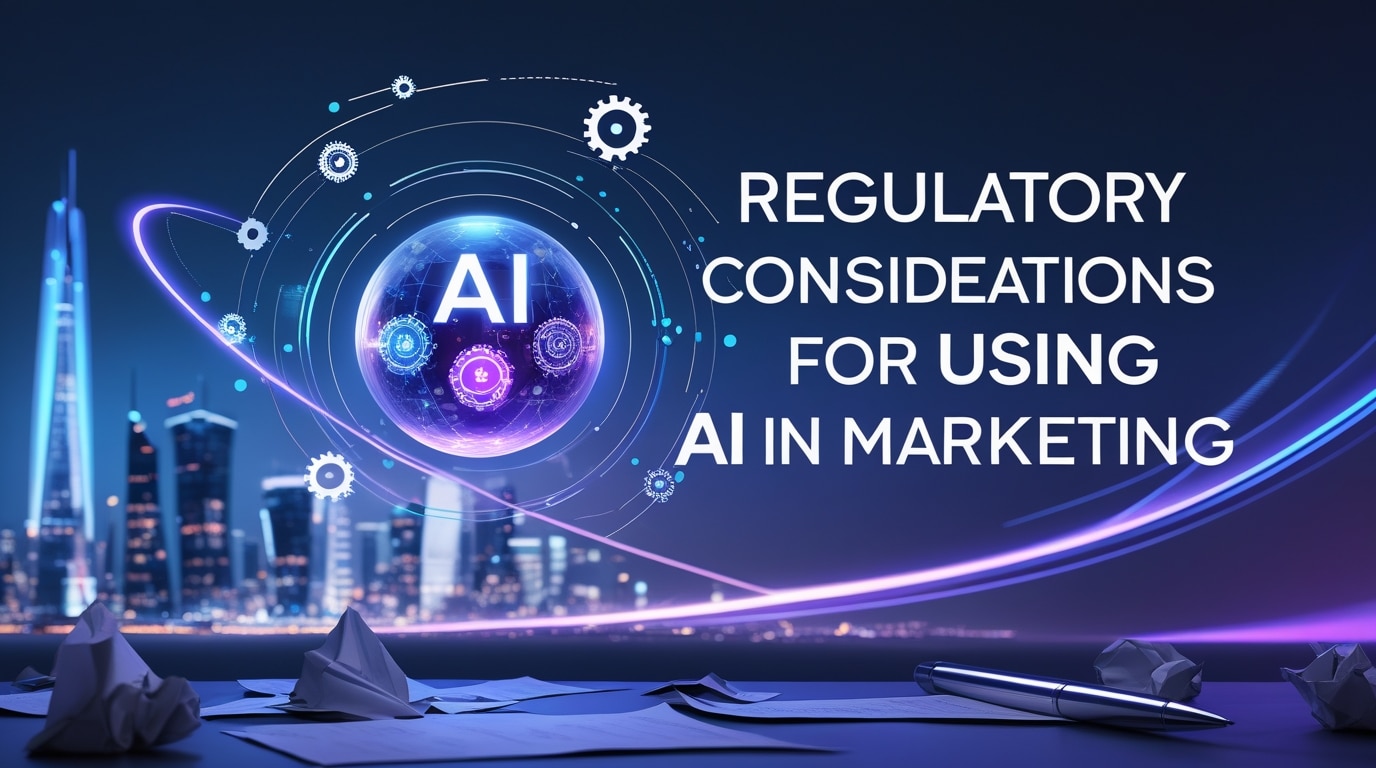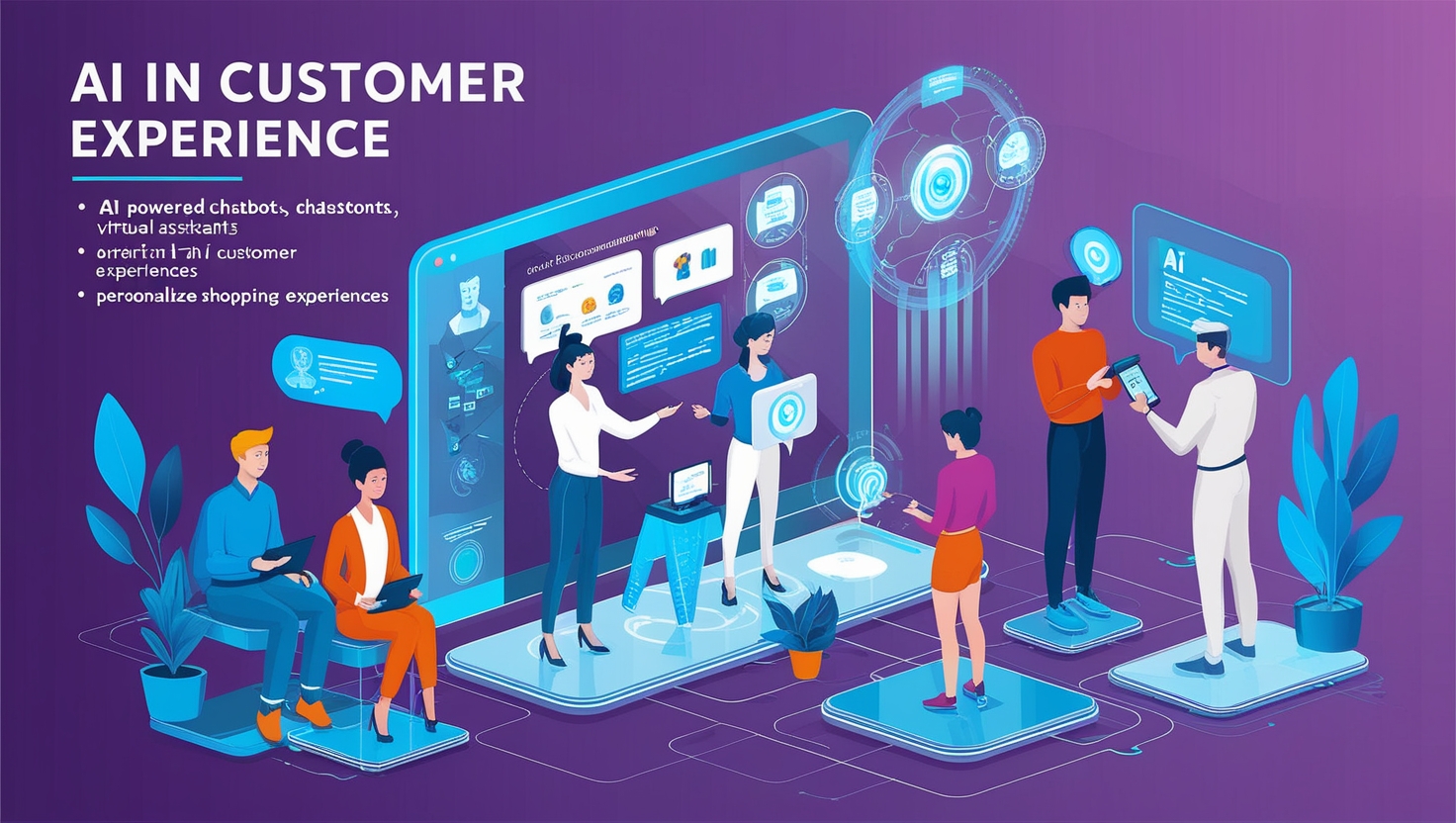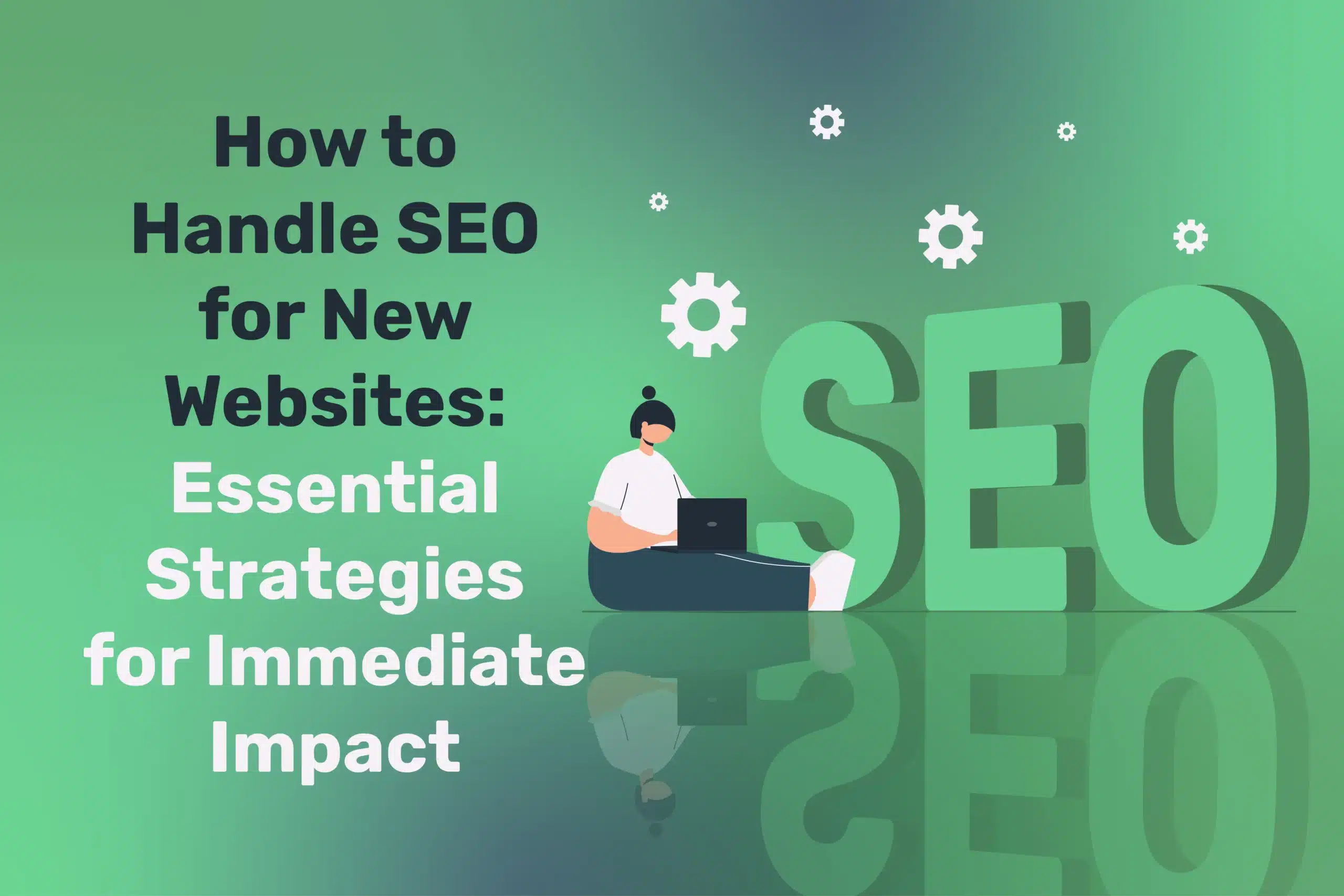
Empowering Teams with Digital and AI Training for Business Growth
Table of Contents
In a rapidly evolving digital landscape, an organisation’s success increasingly hinges on people’s skills and adaptability. Technology is progressing at breakneck speed – what was cutting-edge a few years ago might be commonplace or even obsolete today. Companies must invest in continuous digital and AI training for their teams to keep pace. It’s no longer enough to have a one-time training session on using new software; businesses require a culture of ongoing learning and upskilling to maintain a competitive edge.
Consider this striking insight: More than half of all employees worldwide need to upskill or reskill by 2025 to meet the demands of automation and new technologies. The digital skills gap is a real and urgent challenge. Companies that proactively address it stand to gain productivity, innovation, and employee retention. Those who don’t may fall behind as processes become inefficient and talent seeks more development-focused employers.
This article delves into how digital and AI training can empower your workforce and drive business growth. We will explore the types of digital skills training that are most valuable today, the importance of AI literacy for teams, and best practices for implementing successful training programs. Along the way, we’ll highlight how ProfileTree’s expertise in digital training – from social media and content marketing to artificial intelligence webinars – can be leveraged to transform your team into a tech-savvy powerhouse.
Let’s begin by understanding the scope of “digital training” and why it has become a linchpin for companies aiming to thrive in the digital age.
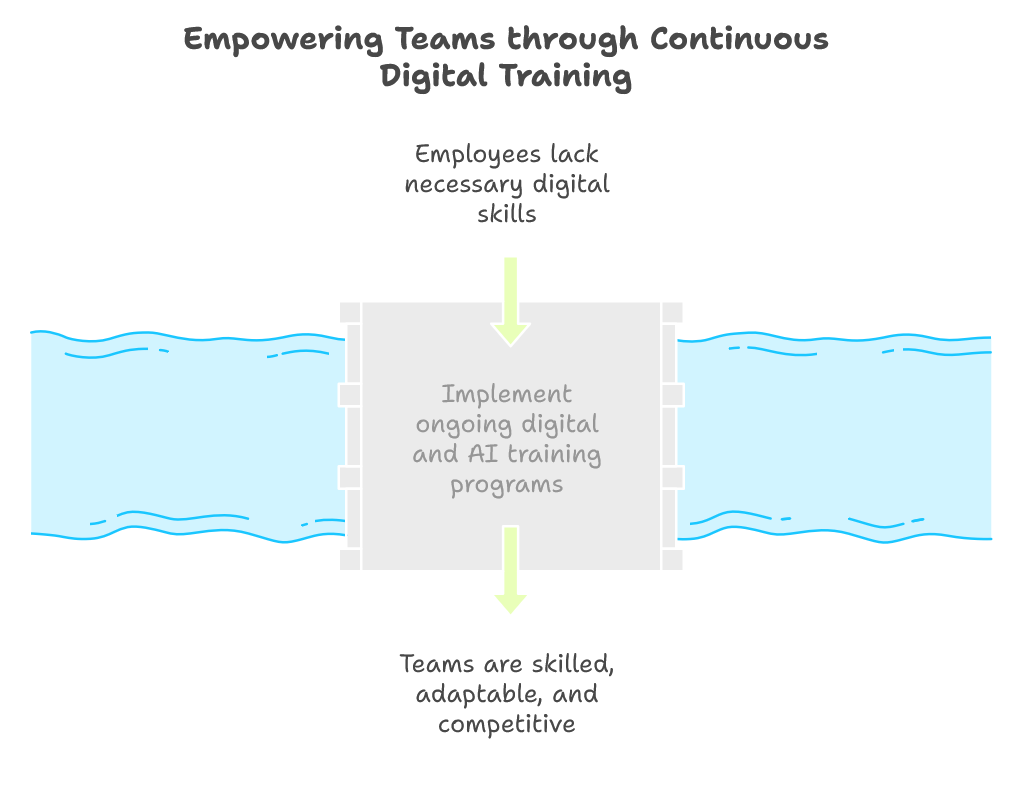
The Scope of Digital Training in Today’s Workplace
“Digital training” is a broad term that covers educating and upskilling employees in the use of contemporary technologies, platforms, and digital strategies. It’s about building competency in the tools and channels that power modern business. The specific focus areas for digital training will vary depending on your industry and company roles but commonly include:
Social Media and Digital Marketing
Training marketing teams (and even customer-facing roles) effectively using social media platforms, email marketing, pay-per-click advertising, and content marketing. This might involve learning to create engaging social content, run ad campaigns, use scheduling or analytics tools, or manage online communities. For example, a small business might train its staff to use Facebook and Instagram for business, understand metrics like reach and engagement, or handle customer inquiries on social platforms.
Content Management Systems (CMS) and Web Skills
Ensuring teams can use the company’s website or intranet effectively. This could involve training on a CMS like WordPress – adding new blog posts, updating page content, correctly uploading images, etc. It may also extend to basic HTML/CSS knowledge for those who need it or training content writers on Search Engine Optimization (SEO) fundamentals so that all web content is publication-ready. ProfileTree often provides website training as part of our development projects, teaching clients how to manage their new site so they are not dependent on developers for every minor change.
Data Analytics and Tools
Many roles now require comfort with data. Digital training might cover using analytics platforms such as Google Analytics for website data, social media insights dashboards, or sales and CRM software. For instance, training a team to understand Google Analytics can help them make data-driven decisions about marketing campaigns or website improvements (e.g., identifying which pages have high drop-off rates and need changes).
Collaboration and Productivity Tools
With the rise of remote and hybrid work, companies rely on digital collaboration tools. Training might include using platforms like Microsoft Teams, Slack, project management tools (Asana, Trello), or cloud storage (Google Drive, SharePoint). While these tools may seem intuitive, formal training ensures all team members use them efficiently and follow best practices (like proper file organisation, tagging, communication etiquette, etc.).
Cybersecurity Awareness
An often overlooked but vital aspect of digital training is educating employees on cybersecurity basics. This includes best practices like recognising phishing emails, using strong passwords or a password manager, understanding data privacy principles, and following company IT security policies. Since employees are the first line of defence in many cyber threats, this training helps protect the company’s digital assets and data.
E-commerce and Online Customer Service
For retail or service businesses with an online customer base, training may cover using e-commerce platforms (like Shopify or WooCommerce), managing online inventory, or handling customer inquiries via chatbots, email, or support tickets. Ensuring that sales and support teams are fluent in these digital customer service tools is key to providing a good customer experience.
Why AI Training is Becoming Essential
On top of general digital skills, Artificial Intelligence (AI) has emerged as a transformative force that is reshaping industries. AI is no longer a niche concern limited to data scientists or IT experts; it’s affecting day-to-day operations in marketing, sales, customer service, product development, and more. Therefore, AI training for employees – helping them understand and harness AI tools – is increasingly essential. Here’s why and what it entails:
Demystifying AI
For many, “AI” evokes images of futuristic robots or complex algorithms far removed from their job. AI training helps demystify the concept, explaining in accessible terms what AI and machine learning are, and how they manifest in tools people might already be using. For instance, employees may not realise that the email spam filter, the recommendation section on an e-commerce site, or the voice assistant in their phone are all AI at work. By understanding this, teams can better appreciate the AI tools introduced in the workplace.
Adopting AI-Powered Tools
There’s a surge of AI-powered software in the market aimed at improving business processes. This includes AI-driven analytics platforms, automation tools (for automating repetitive tasks), chatbots for customer service, AI content generation or proofreading tools, and decision-support systems. Training is needed to help employees learn how to use these tools effectively. For example, a marketing team might get training on an AI-based content optimisation tool that suggests headlines or keywords for better SEO. A customer support team might learn to manage and interpret inquiries through an AI chatbot assistant.
Staying Competitive and Innovative
Companies that leverage AI can often outperform those that don’t by being more efficient or offering innovative products/services. If your competitors use AI to personalise their marketing and you’re not, you could fall behind. Training ensures your team is aware of the AI opportunities in your field. Even basic familiarity with AI capabilities can spark new ideas. Like a salesperson realising they could use an AI tool to automatically log calls and summarise client sentiments (saving time on reporting) or an HR manager discovering AI software that can screen resumes faster. But to get to that point, they need exposure and training.
Ethical and Effective Implementation
Alongside how to use AI, it’s essential to train teams on the ethical considerations of AI. For instance, using AI in decision-making can raise issues about bias or transparency. Ensuring employees understand these aspects will help your company implement AI responsibly. For example, if your team uses an AI tool for selecting job candidates or for credit scoring, they should be aware of the potential biases in algorithms and the need for human oversight. An AI training program can incorporate these discussions to make your workforce tech-savvy and ethically mindful.
AI in Digital Marketing
One area where AI training is particularly beneficial is digital marketing. AI can help automate ad campaigns, predict customer behaviour, segment audiences, and create content (like using AI to draft copy or design basic creatives). ProfileTree has recognised this and offers webinars on Effective Use of AI in Digital Marketing
, which equips marketing professionals with knowledge of leveraging AI to improve campaign performance. TrAIning sessions like these allow marketers to see AI as a helpful assistant rather than a threat.
Embracing AI for Analytics
AI supercharges data analysis. Rather than spending hours manually crunching numbers, AI tools can highlight trends, anomalies, or predictions in data sets. Training your team on AI analytics platforms means they can extract insights faster and more accurately. Imagine a sales manager getting an AI-generated forecast of next quarter’s sales or an operations manager receiving predictive maintenance alerts from IoT sensors analysed by AI – these can be game-changers if the team is ready to trust and use those insights.
Benefits of Investing in Employee Upskilling
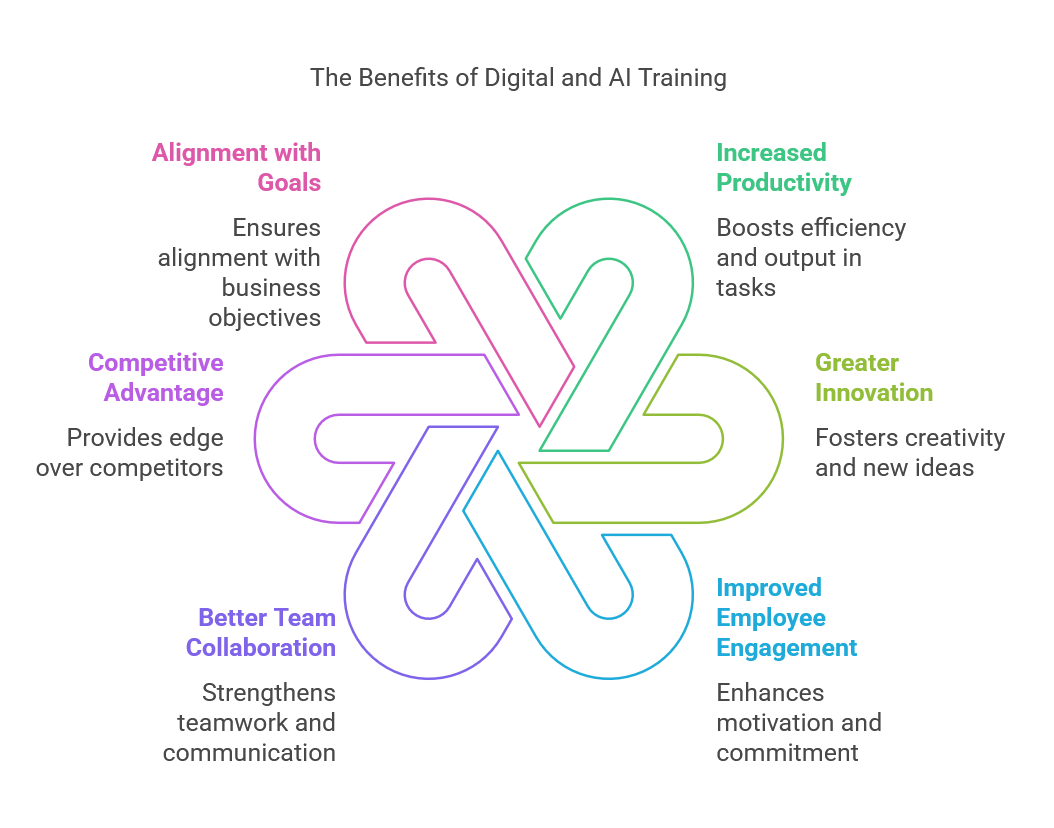
Investing time and resources into training programs yields significant returns for businesses. While training does require commitment (and sometimes a cultural shift towards continuous learning), the benefits far outweigh the costs. Here are some of the key advantages companies see when they prioritize digital and AI training for their employees:
Increased Productivity and Efficiency
When employees are proficient with the tools they use, they work faster and make fewer errors. Imagine a member of your team struggling with an outdated method to pull a report versus one who knows how to use an automated dashboard – the difference in time and accuracy is enormous. Upskilling your team in the latest software or processes streamlines workflows. For example, teaching a team project management software can eliminate hours lost in miscommunication or task duplication. AI automation skills can free staff from mundane tasks, allowing them to focus on higher-value work. The result is an overall boost in productivity.
Greater Innovation and Adaptability
A trained workforce is more confident in experimenting with new ideas and technologies. When people understand how digital tools and AI work, they’re more likely to propose creative solutions that leverage these tools, fostering a culture of innovation. Moreover, technology is constantly changing; a team used to learning new things will adapt quickly to new platforms or market shifts. They become proactive in acquiring new skills as needed rather than reactive or resistant.
Improved Employee Engagement and Retention
Employers often underestimate how much employees (significantly younger generations) value professional growth. Offering training opportunities signals that the company is invested in their development. This can increase job satisfaction and loyalty. Employees who feel they are growing are less likely to seek new jobs. Additionally, involving employees in exciting trAIning like AI workshops can re-energize their interest in their role. It breaks the monotony and shows them a path for progression (e.g., becoming the go-to AI tools expert on the team). All of this contributes to higher morale and retention.
Better Team Collaboration
Cross-department collaboration improves when everyone has a baseline understanding of digital concepts and tools. Marketing can work more smoothly with IT if both understand the language of data and SEO. Sales and marketing alignment improves if both are trained in using the CRM and analysing customer data. A standard skill set and vocabulary around technology reduce friction and miscommunication between teams.
Competitive Advantage
Training your team can become a major differentiator in industries with low digital proficiency. If your competitors are slow to adopt new digital strategies, having a highly skilled team means you can implement new initiatives much faster. For example, if other companies in your sector haven’t yet tapped into AI for marketing and have a trained team, you can reach customers more effectively or optimise your ad spend. Essentially, upskilling can help lower the playing field so that smaller companies can compete with larger ones or push a leading company further.
Alignment with Digital Transformation Goals
Many companies embark on digital transformation projects – revamping systems, adopting new tech, and overhauling processes. These efforts can fail if employees aren’t on board or capable of using the latest systems (remember the earlier stat: **70% of digital transformations fail to meet their goals, often due to people and process issues, not just technology). Training ensures your staff can execute and sustain the transformation. For example, suppose you implement a new digital customer relationship system as part of a transformation. In that case, training ensures the sales and support teams know how to use it effectively in their daily work. (For more on transforming success, our article on Driving Digital Transformation with AI Automation provides insights, and you’ll see that people-focused strategies like training are a recurring theme.)
Empowered Decision Making
Training in data and AI can make your employees better decision-makers. With analytical skills and an understanding of data tools, they can interpret information and metrics independently rather than waiting for a data analyst to generate a report. This democratisation of data leads to faster decisions on the front lines. For example, a store manager trained in using a business intelligence dashboard can decide on inventory orders based on actual sales trends without always needing to escalate to corporate analysts.
In a nutshell, well-trained employees perform better and contribute more. They feel confident taking the initiative because they have the knowledge to back it up. And when your whole organisation continuously learns, you become agile – ready to seize new opportunities or tackle challenges head-on.
Implementing an Effective Training Program
Understanding the need for training is one thing; effectively implementing it is another. Many companies struggle to roll out training initiatives that stick and translate into better performance. Here are some best practices and steps to implement a successful digital and AI training program within your organisation:
Assess Skills Gaps
Start by identifying what skills your team currently has and what’s lacking. This could be done through surveys, assessments, or consulting with department heads. For instance, your marketing team might be excellent at traditional campaigns but lacks advanced SEO knowledge, or your operations team could benefit from automation training. Also, consider future needs – if you plan to adopt new software or AI tools, include those skills in your assessment. ProfileTree often helps businesses conduct digital skills audits to pinpoint where training will have the most impact.
Set Clear Objectives
Based on the identified gaps, set specific training goals. Rather than “we need more digital skills,” define it as “we want the content team to learn SEO copywriting and the sales team to learn how to use the new CRM”. Clear objectives will guide the program structure and help measure success later. If AI adoption is a goal, an objective might be to “introduce AI-driven automation to reduce manual data entry by 50% and train relevant staff to manage the new AI tool.
Tailor the Training Content
One size does not fit all. Customise the training modules to be relevant to each team or role. Developers might need training on a new programming framework, while HR might need training on a digital onboarding platform – these are entirely different. Even for broad topics like “digital marketing,” consider the proficiency level of the participants. Beginners might need an intro to social media marketing, whereas advanced users might jump into analytics and A/B testing techniques. Tailoring also means making it industry-relevant. If you’re in hospitality, training examples should ideally relate to hospitality scenarios; if in finance, use finance case studies. This relevance helps participants see the value and application of their learning.
Choose the Right Format
There are various ways to deliver training – workshops, online courses, webinars, one-on-one coaching, on-the-job training, etc. Often, a blend works best:
- Interactive Workshops are good for hands-on practice (e.g., a workshop on using a particular software where everyone can follow along on their laptop).
- Webinars and Online Courses: Useful for remote teams or distributing knowledge across multiple locations. They can be recorded for future reference. ProfileTree, for example, offers free interactive AI webinars
accessible to anyone, which is a great way to get started on AI training without heavy costs. - Mentorship or Coaching: Sometimes, internal expertise can be utilised. You can have inter-department knowledge-sharing sessions if one department is strong in an area. Or identify “digital champions” in your team who get more advanced training and then mentor others.
- Self-paced Learning: Provide resources (subscriptions to e-learning platforms, recommended courses, etc.) for those who want to learn more at their own pace. Not everyone learns best in a classroom setting, so having options is key.
Make it Continuous and Incremental
Instead of a one-off training blast, create a continuous learning culture. This could be monthly training sessions, a quarterly workshop series, or encouraging teams to spend a few hours each month on learning. Micro-learning (small, digestible modules) can be more effective than multi-day marathons, which risk information overload. Technology and best practices change, so regular refreshers or advanced sessions keep the team’s knowledge current. For example, SEO algorithms update frequently – a periodic SEO training update can help your content team adjust their strategies accordingly.
Encourage Practical Application
People learn best by doing. After training, set up projects or tasks where employees can apply what they learned while it’s fresh. If they attended a training on video content creation, perhaps task the team with creating a short promotional video the following week. If the sales team learned a new CRM feature, have them practice by inputting real data and using the feature in their next sales cycle. Practical application not only cements the knowledge but also quickly shows tangible benefits to the business.
Gather Feedback and Measure Impact
Continuously collect feedback from participants. Was the training useful? Was it too basic or too advanced? What would they like to learn more about? This helps improve future sessions. Also, try to measure the impact. Did website traffic improve after SEO training? Are support tickets resolved faster after the customer service team took a course on a new system? Such metrics can be tricky to attribute directly but look for positive trends. Employee retention or satisfaction surveys can indicate if training contributes to higher morale.
Lead by Example
Management and leadership should also partake in training. When employees see their bosses also learning (like a CEO attending an AI overview session alongside everyone), it reinforces that the company truly values it. Leadership can then better understand what the team is learning and can support them in applying new skills. It also breaks any stigma that training is only for when you’re lacking in something; instead, it’s framed as something everyone does to grow.
ProfileTree’s Approach to Digital Upskilling
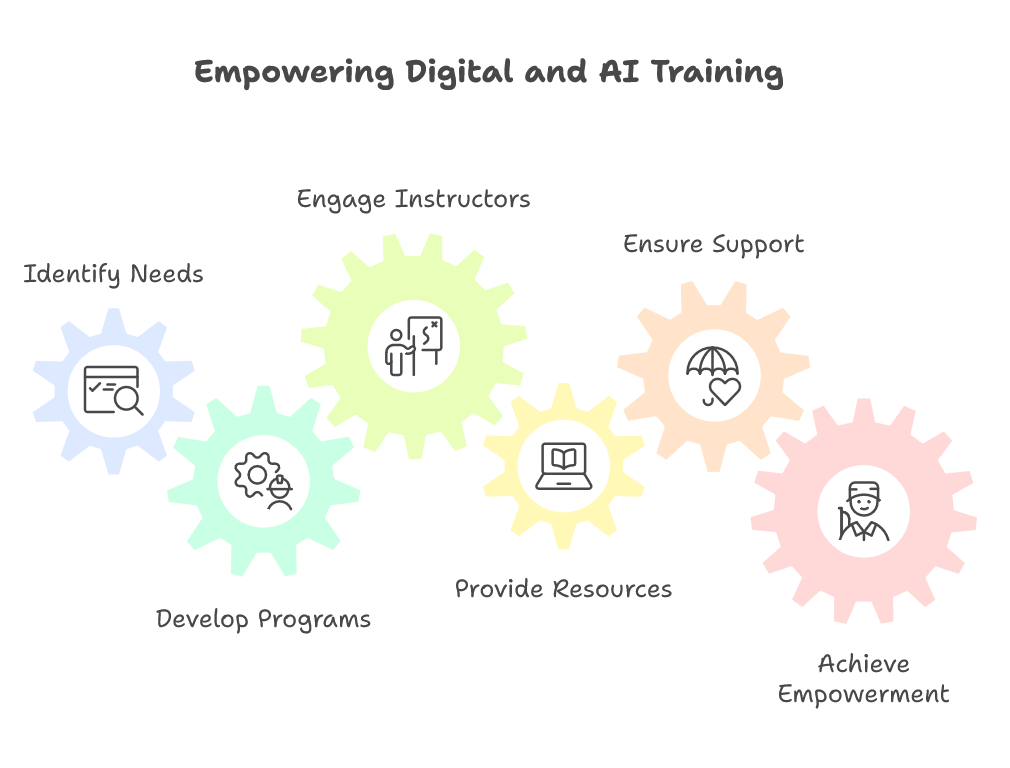
To wrap up our insights, it’s worth looking at how a professional agency like ProfileTree can assist in the digital and AI training journey. ProfileTree doesn’t just build websites and run marketing campaigns; we also specialise in digital training and consulting to empower clients to leverage technology confidently. Here’s how we approach upskilling:
Bespoke Training Programs
We don’t believe in one-size-fits-all. ProfileTree works with businesses to develop training programs tailored to their needs and industry context. Whether your team needs a crash course in content marketing, an in-depth SEO workshop, or step-by-step guidance on adopting AI tools, we customise the curriculum. Our experts often begin with a discovery session to understand your current capabilities and goals, ensuring the training hits the mark.
Expert Instructors and Real-World Insights
Our training sessions are led by practitioners – digital marketers, web developers, AI specialists – who apply these skills daily. Your team isn’t learning from a generic textbook but getting real-world examples and tips from experience. For instance, if we conduct training on video marketing, our video production team might share a case study of how a YouTube campaign drove engagement for a client, perhaps detailing the process we used (script writing, SEO for YouTube, editing techniques, etc.). These insights make the training more engaging and credible.
Interactive and Hands-On
We emphasise interactive learning. Our AI webinars, for example, are interactive sessions
where businesses can see live demos of AI tools and even try simple AI exercises themselves under guidance. In social media training, we might have attendees draft sample posts or ad copy during the session. This isn’t a passive lecture – we involve participants, so they learn by doing and can ask questions in real time.
Resource Provision
ProfileTree ensures that teams have resources to refer back to after formal sessions. This could be slides, how-to guides, checklists, or even video recordings of the training (when applicable). In fast-changing fields like SEO or AI, having up-to-date resources is crucial. We often provide cheat sheets for things like “On-Page SEO Best Practices” or “Checklist for Publishing a Blog Post” that serve as daily references for teams implementing what they’ve learned.
Follow-up and Support
Training shouldn’t be a one-off event. ProfileTree offers follow-up support – be it Q&A sessions a few weeks later or availability via email to clarify any doubts as teams apply the new skills. Sometimes, after training, companies might need a bit of consulting to implement a tool or strategy; we step in to assist in those initial phases, effectively walking hand-in-hand until the client is confident. For example, a business might want to start a pilot project using a chatbot after an AI training webinar. ProfileTree could help set it up and ensure the team knows how to maintain it.
Comprehensive Digital Transformation Consulting
Beyond specific skill training, ProfileTree provides digital transformation consulting. This means we look at the bigger picture – how can all these skills and tools integrate to transform your business operations and outcomes? Perhaps your end goal is to automate your sales process. We would not only train your team on the individual components (CRM, email automation, AI lead scoring) but also create a roadmap and help orchestrate the process changes needed. This holistic approach ensures that training isn’t happening in a vacuum – it’s tied to strategic objectives and followed through with execution support. (For an idea of how these pieces fit into transformation, check out our article on Driving Digital Transformation with AI Automation, which complements the training aspect by focusing on strategy and implementation.)
Local and Industry Expertise
Based in Northern Ireland and serving clients globally, ProfileTree keenly understands various market dynamics. We have worked with local government bodies, tourism boards, manufacturing firms, and more. This diversity means we can bring cross-industry insights. For instance, an e-commerce SEO trick learned from a retail client could inspire an approach for a B2B company. Moreover, we can incorporate local context (like knowledge of the UK/EU digital landscape) where relevant. And yes, we practice what we preach – our team is constantly learning new tech and trends to stay ahead, so you can trust that what we train is current and tested.
Empowering your team through knowledge is one of the best investments you can make as a business. In the next section, we conclude with thoughts on taking action and how to start a training journey that positions your company for long-term success.
What Does AI Training Include?
AI training can be tailored to your organisation’s needs, but it generally covers a range of topics, such as:
AI Fundamentals: Teaching the basics of artificial intelligence and machine learning in understandable terms – what AI can and cannot do, and key concepts like algorithms, models, and data training.
Tool-Specific Training: Hands-on instruction for the specific AI tools or platforms your company is implementing. For example, if you’ve introduced a new data analytics platform with AI capabilities, your analysts should be trained to use its features in their day-to-day work.
Data Literacy: Since AI often revolves around data, employees may need training in handling and interpreting data. This could include learning how to prepare datasets, understand data biases, or read AI-driven insights correctly.
Ethical and Responsible AI Use: It’s increasingly important to train staff on the ethical considerations of AI. This includes understanding data privacy and consent issues and avoiding bias in AI decisions. A well-rounded AI training programme will address how to use AI responsibly and in compliance with regulations.
Continuous Learning: The AI field evolves quickly. Practical AI training doesn’t happen just once; it’s ongoing. Many businesses establish continual learning resources – such as monthly workshops or an internal knowledge base – so employees can keep up with the latest AI trends and features.
By covering these bases, AI training ensures that your team can operate today’s tools and is prepared for tomorrow’s advancements.
Case Study: Gaining an Edge with AI Skills
Imagine a professional services firm (e.g., an accounting and consulting company) that decided to integrate AI into its operations. They invested in an AI-driven data analytics system to improve financial forecasting for their clients. Initially, only a few specialists knew how to use it, limiting its benefits. Recognising this, the firm rolled out an AI training initiative. Consultants and analysts were trained to correctly input data, interpret the system’s predictive outputs, and tweak basic machine learning models for custom analyses. As a result, the firm saw significant improvements. Junior analysts, empowered with AI-driven insights, could perform analysis that previously required senior experts – speeding up project turnaround times. The accuracy of financial forecasts improved, leading to higher client satisfaction. Moreover, multiple team members could confidently explain AI-generated insights in client meetings, which impressed clients and built trust. This firm’s story demonstrates that when staff are well-versed in AI, the whole organisation benefits – from internal efficiency gains to enhanced customer service quality.
Looking Ahead: AI as Part of Company Culture
Adopting AI is not a one-time checkbox; it’s an ongoing journey. As your business grows and technology advances, new AI applications will arise. Making AI training part of your company culture encourages a forward-thinking mindset. Employees won’t be intimidated when a new AI tool is introduced – they’ll be eager to learn it, knowing it’s an opportunity to improve their work. It’s also worth noting that having an AI-trained workforce can be attractive when recruiting new talent or pitching to clients. It signals that your company is modern, efficient, and unafraid to embrace cutting-edge solutions. In contrast, businesses that ignore AI training may struggle to hire younger professionals who expect modern workplaces or lose clients to competitors offering more innovative, AI-enhanced services.
Conclusion: Equip Your Team for the Digital Future
The businesses that will thrive in the coming years are not necessarily the ones with the most capital or the latest gadgets – they will be the ones with the most capable and adaptable people. Empowering your team with digital and AI training empowers your business to innovate and excel. It creates a ripple effect: skilled employees execute better strategies, serve customers more effectively, and drive growth, opening up new opportunities for everyone in the organization.
If you haven’t, now is the time to assess your team’s skills and prioritise digital training. Whether it’s getting your sales staff comfortable with a new CRM, teaching your marketing team the nuances of SEO, or introducing your entire company to the possibilities of AI automation, each step taken in upskilling is a step toward a stronger competitive position. Remember, even minor improvements – like learning a shortcut in software or a new approach to social media engagement – can make a big difference in efficiency or revenue over time.
Embarking on this journey is easier with the right partner. ProfileTree has a proven track record in providing digital services and educating and uplifting teams to use those services to their full advantage. We believe in a collaborative approach: when our clients learn and grow, we grow together. From customized training workshops to strategic consulting on digital transformation, ProfileTree is here to support you every step of the way.
The digital future is already here. The question is – is your team ready for it? If you want to ensure they are, and by extension, secure the future of your business, book a call with ProfileTree today. Let’s discuss your training needs, develop a tailored upskilling plan, and unlock the full potential of your people. Together, we’ll equip your team with the knowledge and confidence to take your business to new heights in the digital age.


